Pipedreams Euro-Tour
April 28 - May 11, 2006
Mönchsdeggingen (Saint Martin)
Deggingen is first mentioned in the year 1007 in a document of the emperor Heinrichs II, though a cloister existed in this place from an earlier time, circa 959, and a Romanesque church building served as the basis for the Baroque structure we see today. This region is called the Nördlinger Ries, and is a crater formed by the crash of a meteorite 15-million years ago. The original facility was taken over by the Benedictines in 1142, and has been associated with the Oettingen-Wallerstein family since 1348. Following a fire in 1513, the monastery was redeveloped under Abbott Alexander Hummel. Secularization occurred in 1802, when ownership of the site was transferred to the Oettingen-Wallerstein family. The property reverted to monastic use in 1950, when it became a novitiate. The nearby town’s population today numbers 1,542 inhabitants.
Links and resources
Maihingen (Abbey Church)
In 1459, the monastery was founded by the Order of Saint Brigitte, and from 1607 until the secularization in 1802, it was the home of a Minorite Community. The Minorites built the monastery buildings in 1703 and the Baroque church in 1712-19.
The organ in the former Minorite Church
of Maihingen was built in 1737 by Johann Martin Baumeister of Eichstätt. After the secularization, there were only a few services in the former abbey church, as the building was owned privately by the Principality of Öttingen. The organ had not been used for over 100 years, and thus, had hardly been altered. During the restoration of 1988-90, the firm of Steinmeyer abstained from ‘cosmetics’ and carried out only essential repairs.
Links and resources
Neresheim
| |
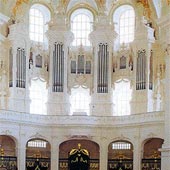 |
Neresheim Abbey, founded in 1095 by Graf Hartmann I., has been a Benedictine Abbey since 1106. The baroque abbey church on the Ulrich hill has been built in 1747-1792 by the famous South German masterbuilder, Balthasar Neumann (83 m length, 32 m heigth). The Tyrolean Martin Knoller created the seven cupola frescoes in 1770-1775. In 1803, the abbey was secularized and the church has been transfered to the Prince of Thurn and Taxis. It was not until 1920, that the Benedictine Abbey and the cloister life was re-established. The abbey church has been restored in 1966-1975.
The organ is placed on the west gallery of these large baroque church. The instrument has 3523 sounding pipes, and 30 not sounding pipes in facade. The reverberation time is about 6-8 sec.
In 1626-29, a new organ has been built by Mathes Maurer from Giengen for the old, romanic church. This instrument was moved to the new baroque abbey church in 1781-82. Joseph Hoess from Ochsenhausen built a new choir organ. In 1792, a new gallery organ was contracted with Johann Nepomuk Holzhey (organ case contracted with Mr. Weissenhorn from Ottobeuren), the organ was completed in 1797 and inaugurated on January 1st, 1798.
| |
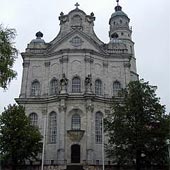 |
In 1837, the organ was repaired by Johann Michael Schultes (a pupil of Holzhey, who opened his own business at Neresheim), further repairs in 1857 (Link from Giengen) and 1897/1913 (Spaeth from Mengen-Ennetach). In 1929, the old console was put in storage, a new electric action and console was added, some pipes exchanged and revoiced. In 1949, a new choir organ (II/26) was built by Steinmeyer from Oettingen and connected to the main console (electric action), the old case from the Hoess organ was retained. In 1966-75, the abbey church was renovated, the Holzhey organ was dismantled and stored. A new console was built for the choir organ in 1975. In 1972-79, the Holzhey organ was restored by organbuilders Kuhn from Maennedorf (Switzerland). The mechanical action has been reconstructed, some lost pipes and stops were reconstructed after historical examples of other Holzhey organs (2033 from 3553 pipes are still original).
Johann Nepomuk Holzhey grouped the four organ cases around four pillars on the west gallery. The four cases are connected in the middle by three smaller cases as “bridges”. Above and below these bridges are large windows. Also the organ facade is built in a bow because of the curved facade of the church. Therefore the organ looks like the famous Gabler Organ at Weingarten Abbey, but also here the organbuilder has to built a very long, complicated mechanical action.
Links and resources
The day to day…

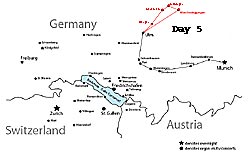
 Notes from the Road - travel log, day 5
Notes from the Road - travel log, day 5 Michael Barone’s pictures from the tour
Michael Barone’s pictures from the tour Images from Mönchsdeggingen
Images from Mönchsdeggingen Images from Maihingen
Images from Maihingen Images from Neresheim
Images from Neresheim Day 4 - Rot, Ochsenhausen & Ulm
Day 4 - Rot, Ochsenhausen & Ulm Day 6 - Obermarchtal & Hechingen
Day 6 - Obermarchtal & Hechingen Main Tour Page
Main Tour Page
 Notes from the Road - travel log, day 5
Notes from the Road - travel log, day 5 Images from Mönchsdeggingen
Images from Mönchsdeggingen Find detailed organ specifications in our Tour Book
Find detailed organ specifications in our Tour Book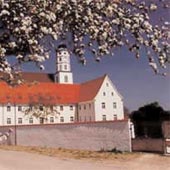
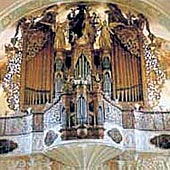
 Notes from the Road - travel log, day 5
Notes from the Road - travel log, day 5 Images from Maihingen
Images from Maihingen Description of monastery
Description of monastery Find detailed organ specifications in our Tour Book
Find detailed organ specifications in our Tour Book

 Notes from the Road - travel log, day 5
Notes from the Road - travel log, day 5 Images from Neresheim
Images from Neresheim Wikipedia - Neresheim
Wikipedia - Neresheim Detailed images of Neresheim Abbey
Detailed images of Neresheim Abbey Architectural history of Neresheim Abbey
Architectural history of Neresheim Abbey Find detailed organ specifications in our Tour Book
Find detailed organ specifications in our Tour Book

